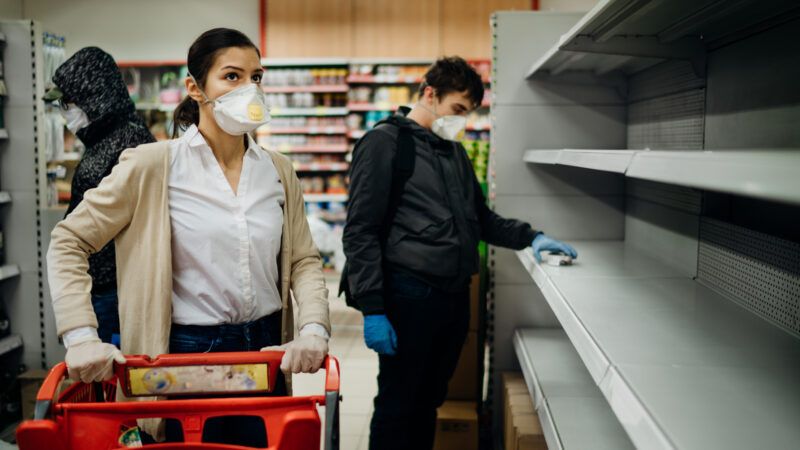Did Anti-Price Gouging Laws Lead to More COVID-19 Deaths?
A new paper finds that the shortages produced by emergency price controls led to more social interactions as people searched for scarce goods. Additional COVID-19 deaths weren't far behind.

Price gouging laws are generally derided by economists for causing shortages during emergencies. During the COVID-19 pandemic, have they also led to more deaths? A provocative new paper published today by Utah State University's Center for Growth and Opportunity posits that the shortages caused by government-imposed price controls led to increased numbers of people visiting retail stores in search of scarce products. That overcrowding in stores, the researchers argue, led to more COVID-19 cases and deaths.
"While mitigation policies primarily sought to decrease social contact among individuals to flatten the infection curve, price-gouging regulation may act against this goal by creating shortages that result in increased consumer searches for goods," write the study's authors, economists Rik Chakraborti and Gavin Roberts. "The crowds that this produced led to more crowding in stores, and thus more COVID-19 cases and deaths."
In their paper released today, the two used cellphone mobility data compiled in the Device Exposure Index (DEX), which measures how many devices a smartphone is exposed to at commercial locations, to see whether those shortages led to more social interactions as people traveled around town looking for goods.
Using the DEX, Chakraborti and Roberts found that "activation of price-gouging regulation led the average individual's social contacts to increase by at least 3.3 other devices per device per day" when holding constant income effects, large nationwide daily changes to the number of social contacts, and measures of the pandemic's severity, which includes cases, deaths, and whether a lockdown order was in effect.
The price control-induced increase in social contacts, the study found, led to 57 to 184 additional daily confirmed COVID-19 cases in the average state where anti-price gouging laws were in effect. Those policies also produced an additional 12 to 17 daily COVID-19 deaths on average per state.
The additional deaths caused by price gouging laws make up about 25 percent of all COVID-19 deaths from early April in those states, according to the study.
Chakraborti, a professor at Christopher Newport University, tells Reason that the pandemic has provided a unique opportunity to study the empirical effects of price gouging laws.
Economic theory has long predicted that emergency limits on price increases will lead to shortages by encouraging consumers to buy more of a product than they need, while limiting the incentive of entrepreneurs to increase supply.
Measuring the impact of price gouging laws, however, is difficult given that the natural disasters for which they are invoked usually affect only a few states at most, all of which are likely to impose price controls at the same time.
The pandemic, in contrast, has been a nationwide phenomenon that saw states impose restrictions on price increases in a staggered fashion, or not at all. That, says Chakraborti, allows researchers to better tease out the impact of price gouging laws on the availability of goods, and, in the context of the pandemic, COVID-19 deaths.
In a previous study published in the Journal of Private Enterprise in January, Chakraborti and Roberts established that price gouging did produce expected shortages of high-demand products like toilet paper and hand sanitizer by looking at Google search trends for those items. The thinking there was that shortages on store shelves would lead to more people looking online for products.
DEX data also breaks down its data by income quartile based on the estimated census block location of a household.
Chakraborti and Roberts were also able to measure increased searches and social contacts by income group by looking at DEX data on the estimated location of a cellphone owner's household down to the census block level and then cross-referencing that with income levels in that census block. They found that poorer households experienced a greater increase in social contacts.
"That's pretty surprising and flies completely in the face of the typical fairness argument that people make" for price control, says Chakraborti. "It's almost a regressive tax on the poor because they have to go out and search for these products more."
This is obviously just one study, so its conclusions should be treated with a grain of salt. Nevertheless, the paper is more evidence of the unintended consequences that come with price controls.
During a pandemic, some of those unintended consequences could be deadly.
Rent Free is a weekly newsletter from Christian Britschgi on urbanism and the fight for less regulation, more housing, more property rights, and more freedom in America's cities.


Show Comments (75)